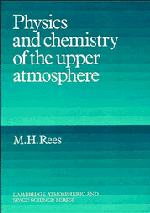Book contents
- Frontmatter
- Contents
- Preface
- Acknowledgements
- 1 An overview
- 2 The interaction of energetic solar photons with the upper atmosphere
- 3 The interaction of energetic electrons and ions with the upper atmosphere
- 4 Collisions and reactions
- 5 Ion and neutral composition of the upper atmosphere
- 6 Temperatures in the upper atmosphere
- 7 Spectroscopic emissions
- 8 Dynamics of the thermosphere and ionosphere
- Appendices
- Index
6 - Temperatures in the upper atmosphere
Published online by Cambridge University Press: 04 April 2011
- Frontmatter
- Contents
- Preface
- Acknowledgements
- 1 An overview
- 2 The interaction of energetic solar photons with the upper atmosphere
- 3 The interaction of energetic electrons and ions with the upper atmosphere
- 4 Collisions and reactions
- 5 Ion and neutral composition of the upper atmosphere
- 6 Temperatures in the upper atmosphere
- 7 Spectroscopic emissions
- 8 Dynamics of the thermosphere and ionosphere
- Appendices
- Index
Summary
Introduction
The subject of this chapter is plural because the neutral gas, the ions and the electrons are generally all at different temperatures in the upper atmosphere. Although each component has energy sources and sinks the temperatures are not independent since, in a collision dominated, partially ionized gas, energy is shared amongst the various constituents. We focus principally on the kinetic temperatures of various species but note that excitation of internal energy can be characterized by vibrational and rotational temperatures in molecules. Rotational relaxation is rapid, and the distribution of rotational lines in a band may be used to infer the kinetic temperature of the gas. Vibrational relaxation is relatively slow so that the vibrational temperature of a molecular species may differ from the kinetic temperature of the gas.
Temperature is the observable parameter in the energy balance of the thermosphere. It is important, therefore, to understand the physical processes that underlie the energetics of the region and thereby control the altitude profiles of the several temperatures. In addition, temperature influences processes other than those associated with energetics. We have already pointed out in Chapter 5 that several reaction rate coefficients are temperature-dependent, so that the composition of the thermosphere and the ionosphere is influenced by the thermal structure.
- Type
- Chapter
- Information
- Physics and Chemistry of the Upper Atmosphere , pp. 100 - 137Publisher: Cambridge University PressPrint publication year: 1989



